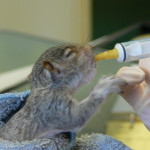By Rick Schubert, Director of Rehabilitation, the Wildlife Clinic

Anyone who has worked on a farm in a temperate climate knows that winter is no time to take a break; wintertime is a race against the clock, reorganizing, repairing, cleaning, planning, and preparing for the upcoming busy season. Wildlife rehabilitation is no different. Although we take in injured adult wild animals 12 months a year, our business spikes in the spring, summer, and fall with the addition of orphaned and displaced neonates. Usually, winter is a slower time for wildlife patient intakes, but it’s a critical period to spend getting ready for the onslaught that spring will bring.
In recent years, this trend has been shifting at the Schuylkill Center. We’ve noticed an uptick in the number of patients we get between November and March, as well as more unusual cases overall. It seems clear that, as weather patterns change, seasonal disruptions emerge in our wildlife populations.
This winter, we’ve treated a broad-winged hawk, usually in Argentina for the winter; four rare red-shouldered hawks, one with a fishing hook through its wing; and both bats and woodchucks out of hibernation despite the cold. And then there are the baby squirrels.
 This year we received the latest litter of orphaned baby squirrels I’ve ever seen in 17 years of wildlife rehabilitation. They were dropped off on November 15 after the mother was struck by a car and killed, and I estimated their age at less than two weeks, meaning they were born the first week of November. I thought to myself, well, at least they’re Scorpios, so they’ve got that going for them, but they were born quite out of season. In the northeastern United States, the gray squirrel has two litters a year, one in late winter and one in late summer. November is well outside the normal range.
This year we received the latest litter of orphaned baby squirrels I’ve ever seen in 17 years of wildlife rehabilitation. They were dropped off on November 15 after the mother was struck by a car and killed, and I estimated their age at less than two weeks, meaning they were born the first week of November. I thought to myself, well, at least they’re Scorpios, so they’ve got that going for them, but they were born quite out of season. In the northeastern United States, the gray squirrel has two litters a year, one in late winter and one in late summer. November is well outside the normal range.
We feed our baby squirrels a special milk formula four times a day. At our clinic, we have volunteers working every day from early morning ‘til late at night from March to October. However, by November, most of our volunteers have taken a hiatus. This winter, there simply were not enough staffers to get the required feedings in. Wildlife rehabilitators being a hardcore lot, it was a familiar routine for me to schlep the animals back home and spend my winter nights bottle feeding them in my spare bedroom while my dogs and cats patiently waited outside the door for their turn to be fed – all the while keeping a clinical, hands-off, sterile approach to keep the squirrels from becoming tame. It’s crucial that we not allow animals in our care to habituate to human contact.
Squirrel moms set their babies free at less than three months old, and the clinic doesn’t do it much differently. However, squirrels make it through the winter partially by relying on cached food stores. By the beginning of February, our four winter baby squirrels were old enough to live on their own, and had all the necessary survival skills to make it, but the one thing they lacked was a secret stash of backup food to get them through the lean months. In these situations, wildlife rehabbers do a “soft release.” We home the young squirrels in at a safe location where they have nest boxes and a food supply and release them there, and after they’ve acclimated, we stop feeding them. This winter, we were able to give a second chance to four of nature’s most adaptable, tenacious, intelligent, and fascinating creatures.
